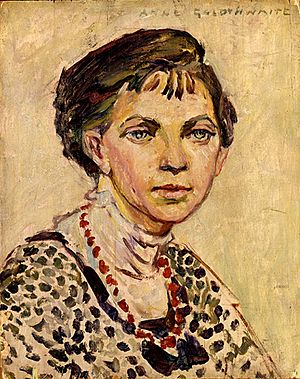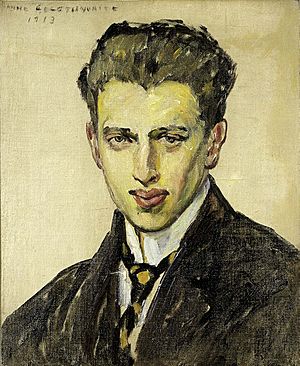Anne Goldthwaite facts for kids
Quick facts for kids
Anne Goldthwaite
|
|
|---|---|

Self-portrait, c. 1906-1913, Smithsonian American Art Museum
|
|
| Born | June 28, 1869 |
| Died | January 29, 1944 New York
|
| Nationality | American |
| Education | Walter Shirlaw at National Academy of Design, Charles Guérin |
| Known for | Portrayal of southerners |
Anne Goldthwaite (born June 28, 1869 – died January 29, 1944) was an American artist. She was a talented painter and printmaker. Anne also strongly supported women's rights and equal rights for everyone.
She first studied art in New York City. Later, she moved to Paris, France. There, she learned about new art styles like Fauvism and Cubism. She became friends with famous artists and writers like Gertrude Stein, Henri Matisse, and Pablo Picasso. Anne was part of an art group called Académie Moderne. They held art shows every year.
When she returned to the United States, her art was shown in a big exhibition. This was the 1913 New York Armory Show. Her work was displayed alongside other modern artists. These included Mary Cassatt, Vincent Van Gogh, Edgar Degas, and Claude Monet. Anne lived in New York City. She spent her summers with family in Montgomery, Alabama. She taught art at the Art Students League of New York for 23 years. In the summers, she taught at the Dixie Art Colony. She also took on art projects and showed her paintings in New York.
Anne became well-known in the Southern United States. She painted scenes of rural African American life. She also helped organize an art show in 1915. This show, called Exhibition of Painting and Sculpture by Women Artists, helped the movement for women to get the right to vote. Anne created art for this important event.
Anne's Early Life
Anne Wilson Goldthwaite was born in Montgomery, Alabama. Her birthday was June 28, 1869. Her father, Richard W. Goldthwaite, was a captain in the Confederacy during the Civil War. Her family later moved to Dallas, Texas. They lived there for most of her childhood.
After her parents passed away, Anne and her two sisters returned to Alabama. Family members took care of them. Anne was expected to become a "southern belle." But a sad event changed her path. Her uncle, Henry Goldthwaite, saw her drawing and painting skills. He offered to help her financially for up to ten years. This was if she moved to New York City to study art. Anne arrived in New York around 1898. She joined the National Academy of Design. There, she learned etching and painting.
Her Art Career
In 1906, Anne Goldthwaite traveled to Paris, France. She stayed at the American Girls' Club in Paris. She explored new art styles like Fauvism and Cubism. These were modern ways of painting. While sketching in the Luxembourg Gardens, she met Gertrude Stein. Gertrude Stein was a very important person in the art world.
Meeting Gertrude Stein gave Anne a chance to join a group of artists. This group included famous names like Henri Matisse and Pablo Picasso. Anne later said that she was lucky to be in Paris during such an exciting time for art. She tried different art studios to find the right teacher. She then joined a small group of young artists. Their work was reviewed by Charles Guerin. This group called themselves the Académie Moderne. They held an art show every spring.
Anne returned to America. She helped bring European Modernism to the country. Her painting, The Church on the Hill (1910–11), was shown in the 1913 New York Armory Show. This was a very important art exhibition. She met another artist, Katherine Dreier, at the show. They became lifelong friends.
Starting in 1915, Anne had a regular work schedule. She spent nine months in New York City and summers in Montgomery, Alabama. She painted lovely pictures of her friends and family. Many of her subjects were other women artists. These included Katherine Dreier and Ellen Axson Wilson, who would become the first lady.
Anne Goldthwaite became known as a key artist in the South. She painted scenes of African American life in rural areas. She used oil paints, watercolors, and etchings to show this lifestyle. She was given two projects to paint murals in Alabama. She completed The Letter Box in Atmore, Alabama in 1937. She also painted The Road to Muskegee in Tuskegee, Alabama in 1939.
Anne taught at the Art Students League of New York for 23 years. She was a very popular teacher. She was also active in several artist groups. She was president of the New York Society of Women Artists from 1937 to 1938. During her summers in Alabama, she advised students at the Dixie Art Colony.
Her work was shown at the Downtown Gallery in New York. This gallery focused on American Modernist artists. Anne had several solo shows there. From 1922 until 1944, she taught and took art projects from her home in New York City. Her art was even part of the painting event at the 1932 Summer Olympics art competition.
Her Activism
Anne Goldthwaite was a strong supporter of equal rights and women's rights. She was active in women's groups. She also fought for equality for ethnic minorities in the South. Her work as an activist and artist often came together.
For example, she helped organize the 1915 Exhibition of Painting and Sculpture by Women Artists. This event helped the movement for women to vote. She also designed a banner for women's suffrage. This banner was shown at a New York Giants baseball game in 1916.
In a 1934 radio interview, Anne shared her thoughts on women artists. She said that women artists were often praised by being told they painted "like a man." But she believed women artists had their own important place. She wanted people to judge art based on if it was good, not if a woman made it.
Later Life
Anne Goldthwaite passed away in New York on January 29, 1944. She had been ill for a long time. Her funeral and burial took place in Montgomery, Alabama.
Works

- A Window at Night, oil on canvas, c. 1933, Metropolitan Museum of Art
- Avenue of the Allies - 5th Avenue, 1918, etching, 1918, Smithsonian American Art Museum
- Bulrushes (No. 1), etching, c. 1895, Montgomery Museum of Fine Arts
- Bulrushes (No. 2), etching, c. 1895, Montgomery Museum of Fine Arts
- Business Section of Boquehomo, etching, not dated, Smithsonian American Art Museum
- Cabin in Alabama, oil on canvas, c. 1915-1925, Smithsonian American Art Museum
- Chapelle du Val de Grâce (No.1), etching, c. 1907, Montgomery Museum of Fine Arts
- Cow and Calf, drypoint, c. 1928, Cleveland Museum of Art
- East Tenth Street (Anne at the Window), etching and drypoint, c. 1928, Cleveland Museum of Art
- Garden Gate, Near Ascain #7, oil on canvas, 1912, Metropolitan Museum
- Grazing, watercolor and black chalk on paper, Metropolitan Museum of Art
- Head of a Negress, Rachel, glazed terracotta sculpture, c. 1929, Metropolitan Museum of Art
- Her Daughter, lithograph, c. 1934, Smithsonian American Art Museum
- Horse and Rider, lithograph, c. 1936, Smithsonian American Art Museum
- Mending (No. 3), lithograph, c. 1936, Smithsonian American Art Museum
- Negro Woman at a Fountain, etching, c. 1920, Smithsonian American Art Museum
- At Montmartre (also called New Year's Night - Cafe Versaille), etching, c. 1910, Smithsonian American Art Museum
- New York Harbor, etching, c. 1915, Cleveland Museum of Art
- Night Series: Dog Baying at the Moon, lithograph, c. 1930, Cleveland Museum of Art
- October in France, etching, c. 1907, Montgomery Museum of Fine Arts
- On the Road to Fontainebleau, etching and drypoint, c. 1907, Syracuse Museum of Fine Arts
- Pont Neuf, Paris, etching, c. 1908, The Downtown Gallery, New York, New York
- Pool Room, lithograph, c. 1935, Smithsonian American Art Museum
- Polo (No. 1), etching, c. 1924, Cleveland Museum of Art
- Portrait of a Young Man, oil on canvas, 1913, Smithsonian American Art Museum
- Quai Votaire (Also known as Bookstalls Along the Seine), etching, c. 1908, Syracuse Museum of Fine Arts
- Sarah Eakin Cowan (1873–1958), watercolor on ivory, 1935, Metropolitan Museum of Art
- Saturday (also called Saturday in Alabama), etching, c.1920, Smithsonian American Art Museum
- Self-Portrait, oil on wood mounted on fiber, c. 1906-1913, Smithsonian American Art Museum
- Selma (No. 1), lithograph, c. 1933, Cleveland Museum of Art
- Southern Street, watercolor and graphite on paper, Metropolitan Museum of Art
- Street Fiddler (also called The Violin), lithograph, c. 1934, Smithsonian American Art Museum
- St. Sulpice, Paris, etching, c. 1908, Montgomery Museum of Fine Arts
- The Green Sofa, oil on canvas, c. 1930-1940, Metropolitan Museum of Art
- The Jaehne House, etching, c. 1922, Cleveland Museum of Art
- The Pantheon, etching, c. 1908, Montgomery Museum of Fine Arts
- Tulips, Cleveland Museum of Art
- Two Black Crows, lithograph, not dated, Smithsonian American Art Museum
- Waterhole, lithograph, c. 1936, Smithsonian American Art Museum
- Ironing, (also called Young Laundress), lithograph, c. 1931, Smithsonian American Art Museum
- Young Woman in White, oil on canvas, c. 1930s, Cleveland Museum of Art
- White Mules on a Bridge, oil on canvas, c. 1930-1940, Metropolitan Museum of Art
See also
 In Spanish: Anne Goldthwaite para niños
In Spanish: Anne Goldthwaite para niños


